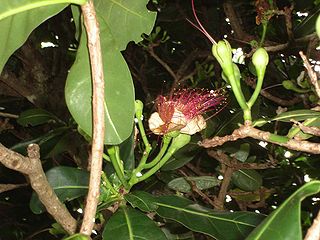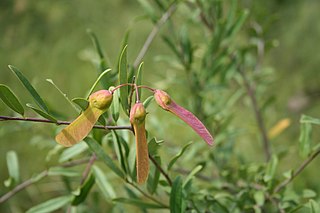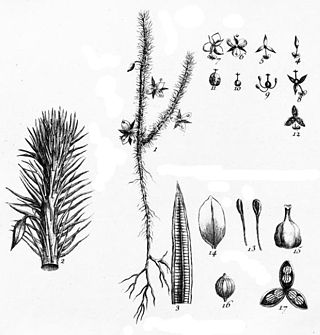
Abutilon is a large genus of flowering plants in the mallow family, Malvaceae. It is distributed throughout the tropics and subtropics of the Americas, Africa, Asia, and Australia. General common names include Indian mallow and velvetleaf; ornamental varieties may be known as room maple, parlor maple, or flowering maple. The genus name is an 18th-century New Latin word that came from the Arabic ’abū-ṭīlūn, the name given by Avicenna to this or a similar genus.

Gentianaceae is a family of flowering plants of 103 genera and about 1600 species.

The Lecythidaceae comprise a family of about 20 genera and 250–300 species of woody plants native to tropical South America, Africa, Asia and Australia.

The Polygalaceae or the milkwort family are made up of flowering plants in the order Fabales. They have a near-cosmopolitan range, with about 27 genera and ca. 900 known species of herbs, shrubs and trees. Over half of the species are in one genus, Polygala, the milkworts.

The Loganiaceae are a family of flowering plants classified in order Gentianales. The family includes up to 13 genera, distributed around the world's tropics. There are not any great morphological characteristics to distinguish these taxa from others in the order Gentianales.

Theobroma is a genus of flowering plants in the mallow family, Malvaceae, that is sometimes classified as a member of Sterculiaceae. It contains roughly 20 species of small understory trees native to the tropical forests of Central and South America.

The Styracaceae are a small family of flowering plants in the order Ericales, containing 12 genera and about 160 species of trees and shrubs. The family occurs in warm temperate and subtropical regions of the Northern Hemisphere.

Azorella is a genus of flowering plants in the family Apiaceae, native to South America, New Zealand, southeastern Australia, and the islands of the Southern Ocean.

Mayaca is a genus of flowering plants, often placed in its own family, the Mayacaceae. In the APG II system of 2003, it is assigned to the order Poales in the clade commelinids. The Cronquist system, of 1981, also recognised such a family and placed it in the order Commelinales in the subclass Commelinidae.

Misodendrum is a genus of hemiparasites which grow as mistletoes on various species of Nothofagus. Its species are all restricted to South America. The name of the genus is incorrectly spelt in a number of ways, including Misodendron and Myzodendron.

The Balanophoraceae are a subtropical to tropical family of obligate parasitic flowering plants, notable for their unusual development and formerly obscure affinities. In the broadest circumscription, the family consists of 16 genera. Alternatively, three genera may be split off into the segregate family Mystropetalaceae.

Olsynium is a genus of summer-dormant rhizomatous perennial flowering plants in the iris family Iridaceae, native to sunny hillsides in South America and western North America.

Drymophloeus is a genus of flowering plant in the family Arecaceae. It is native to New Guinea and nearby islands in Samoa and Maluku.

Hyospathe is a genus of flowering plant in the family Arecaceae, native to South America and Central America. It contains the following species:

Linospadix is a genus of flowering plant in the family Arecaceae. It is native to New Guinea and Australia.

The Van Tassell and Kearney Horse Auction Mart is a building in East Village, Manhattan, New York City. The building was constructed in 1903-04 to the designs of Jardine, Kent & Jardine in the Beaux-Arts Style. It originally served as a horse auction mart that catered to New York's elite families, including the Vanderbilts and Delanos. Each Tuesday and Friday, Van Tassell & Kearney held auctions in the building. Though carriages remained an important part of the business, most advertisements and newspaper stories about the mart concerned the sale of horses, particularly high-priced ribbon winners, polo ponies, hunters, and thoroughbreds. Other sales were devoted to breeding stock and coach horses, including a large group of horses co-owned by Alfred W. Vanderbilt and Robert L. Gerry in 1906.

Thomas Henry Kearney was an American botanist and agronomist known for his work on cotton and date palm breeding, plant taxonomy, and the flora of Arizona.

Rose Eudora Collom was an American botanist and plant collector. She was the first paid botanist of the Grand Canyon National Park. She discovered several plant species, some of which were named in her honor, and collected numerous plant specimens.

The Nassauvieae are a tribe of flowering plants in the family Asteraceae.

Allioideae is a subfamily of monocot flowering plants in the family Amaryllidaceae, order Asparagales. It was formerly treated as a separate family, Alliaceae. The subfamily name is derived from the generic name of the type genus, Allium. It is composed of about 18 genera.




















